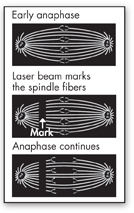Standardized Test Prep
Multiple Choice
Which statement is true regarding a cell's surface area-to-volume ratio?
As the size of a cell increases, its volume decreases.
As the size of a cell decreases, its volume increases.
Larger cells will have a greater surface area-to-volume ratio.
Smaller cells will have a greater surface area-to-volume ratio.
Which of the following is NOT an advantage of asexual reproduction?
simple and efficient
produces large number of offspring quickly
increases genetic diversity
requires one parent
At the beginning of cell division, a chromosome consists of two
centromeres.
centrioles.
chromatids.
spindles.
What regulates the timing of the cell cycle in eukaryotes?
chromosomes
cyclins
nutrients
DNA and RNA
The period between cell divisions is called
interphase.
prophase.
G3 phase.
cytokinesis.
Which of the following is TRUE about totipotent cells?
Embryonic stem cells are totipotent cells.
Totipotent cells are differentiated cells.
Totipotent cells can differentiate into any type of cell and tissue.
Adult stem cells are totipotent cells.
A cell enters anaphase before all of its chromosomes have attached to the spindle. This may indicate that the cell is not responding to
internal regulators.
mitosis.
growth factors.
apoptosis.
Questions 8–10
The spindle fibers of a dividing cell were labeled with a fluorescent dye. At the beginning of anaphase, a laser beam was used to mark a region of the spindle fibers about halfway between the centrioles and the chromosomes. The laser beam stopped the dye from glowing in this region, as shown in the second diagram. The laser did not inhibit the normal function of the fibers.
This experiment tests a hypothesis about
how chromosomes migrate during cell division.
how fluorescent dyes work in the cell.
the effect of lasers on cells.
why cells divide.
The diagrams show that chromosomes move to the poles of the cell as the spindle fibers
shorten on the chromosome side of the mark.
lengthen on the chromosome side of the mark.
shorten on the centriole side of the mark.
lengthen on the centriole side of the mark.
A valid conclusion that can be drawn from this experiment is that the spindle fibers break down
at the centrioles.
in the presence of dye.
when marked by lasers.
where they are attached to chromosomes.
Open-Ended Response
Explain why careful regulation of the cell cycle is important to multicellular organisms.
| Question | 1 | 2 | 3 | 4 | 5 | 6 | 7 | 8 | 9 | 10 | 11 |
|---|---|---|---|---|---|---|---|---|---|---|---|
| See Lesson | 10.1 | 10.1 | 10.2 | 10.3 | 10.2 | 10.4 | 10.3 | 10.2 | 10.2 | 10.2 | 10.3 |
Table of Contents
- Formulas and Equations
- Applying Formulas and Equations
- Mean, Median, and Mode
- Estimation
- Using Measurements in Calculations
- Effects of Measurement Errors
- Accuracy
- Precision
- Comparing Accuracy and Precision
- Significant Figures
- Calculating With Significant Figures
- Scientific Notation
- Calculating With Scientific Notation
- Dimensional Analysis
- Applying Dimensional Analysis





